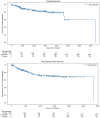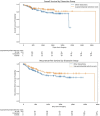Algorithm-based analysis of lymph node dissection strategies and survival outcomes in primary oral squamous cell carcinoma
- PMID: 40308493
- PMCID: PMC12041001
- DOI: 10.3389/fonc.2025.1483921
Algorithm-based analysis of lymph node dissection strategies and survival outcomes in primary oral squamous cell carcinoma
Abstract
Introduction: Recent advancements in treatment approaches for oral squamous cell carcinomas (OSCCs) necessitate a reevaluation of neck dissection techniques and their impact on patient outcomes and morbidity.
Methods: This retrospective study of 250 OSCC patients recruited between 2017-2022 examined the association between neck dissection techniques and survival metrics. Our cohort, drawn from a primary OSCC surgery population at our clinic, provided a rich dataset encompassing demographics, clinical parameters, and detailed surgical records. Two neck dissection techniques were analyzed: the Supraomohyoid Selective Neck Dissection (SND), which targets lymph nodes at Levels I-III, and Other Dissections (OD), which involve a more extensive extraction including Levels IV and V. Kaplan-Meier survival curves and Cox proportional hazards models assessed the influence of lymph node dissection on postoperative outcomes.
Results: Findings indicated that each additional lymph node removed was associated with a 0.289-day increase in hospitalization (p = 0.002), yet no significant link was found between dissection techniques or total lymph node extraction count and survival metrics. Levels I to III emerged as critical areas with the highest likelihood of yielding tumor-positive lymph nodes, emphasizing the significance of these levels.
Discussion: The study suggests that more extensive dissection does not necessarily confer survival benefits, highlighting the importance of strategic surgical focus and the potential for tailored interventions that prioritize disease-specific lymph node levels to optimize patient recovery and prognosis.
Keywords: Kaplan-Meier estimate; head and neck neoplasms; lymph node yield; neck dissection; proportional hazards model; survival rate.
Copyright © 2025 Vollmer, Saravi, Kübler, Müller-Richter, Winter, Nagler, Hörner, Gubik and Hartmann.
Conflict of interest statement
The authors declare that the research was conducted in the absence of any commercial or financial relationships that could be construed as a potential conflict of interest.
Figures




Similar articles
-
Prognostic value of lymph node count from selective neck dissection in oral squamous cell carcinoma.Int J Oral Maxillofac Surg. 2018 Aug;47(8):953-958. doi: 10.1016/j.ijom.2018.03.007. Epub 2018 Mar 30. Int J Oral Maxillofac Surg. 2018. PMID: 29606561
-
Elective neck dissection in oral carcinoma: a critical review of the evidence.Acta Otorhinolaryngol Ital. 2007 Jun;27(3):113-7. Acta Otorhinolaryngol Ital. 2007. PMID: 17883186 Free PMC article. Review.
-
Prognostic value of lymph node involvement in oral squamous cell carcinoma.Clin Oral Investig. 2022 Nov;26(11):6711-6720. doi: 10.1007/s00784-022-04630-7. Epub 2022 Jul 27. Clin Oral Investig. 2022. PMID: 35895143 Free PMC article.
-
Assessing Prognostic Value of Quantitative Neck Dissection Quality Measures in Patients With Clinically Node-Negative Oral Cavity Squamous Cell Carcinoma.JAMA Otolaryngol Head Neck Surg. 2022 Oct 1;148(10):947-955. doi: 10.1001/jamaoto.2022.2312. JAMA Otolaryngol Head Neck Surg. 2022. PMID: 36074415 Free PMC article.
-
Standards and Definitions in Neck Dissections of Differentiated Thyroid Cancer.Sisli Etfal Hastan Tip Bul. 2018 Oct 1;52(3):149-163. doi: 10.14744/SEMB.2018.14227. eCollection 2018. Sisli Etfal Hastan Tip Bul. 2018. PMID: 32595391 Free PMC article. Review.
References
-
- Graboyes EM, Gross J, Kallogjeri D, Piccirillo JF, Al-Gilani M, Stadler ME, et al. . Association of compliance with process-related quality metrics and improved survival in oral cavity squamous cell carcinoma. JAMA Otolaryngol Neck Surg. (2016) 142:430–7. doi: 10.1001/jamaoto.2015.3595 - DOI - PMC - PubMed
LinkOut - more resources
Full Text Sources

